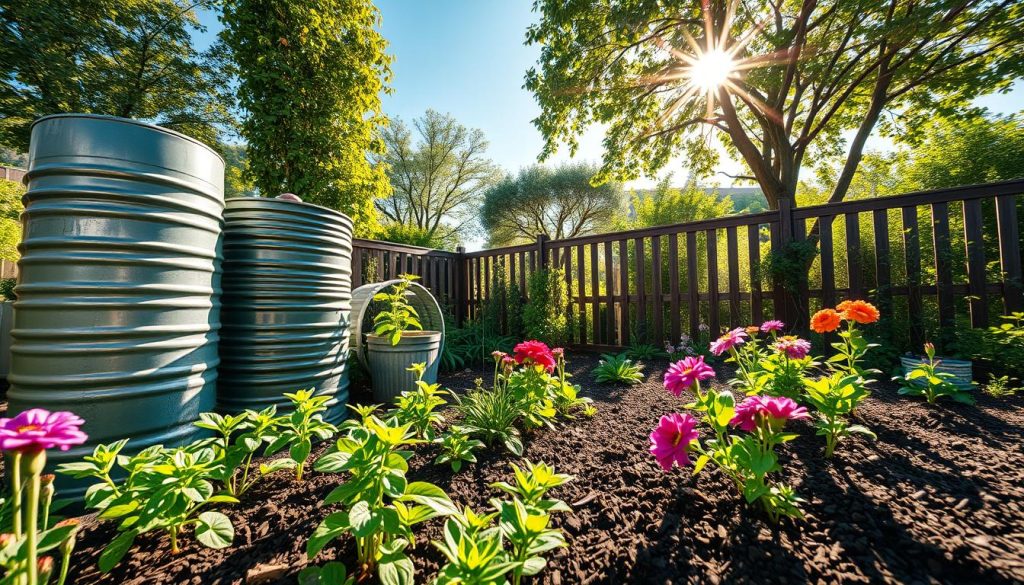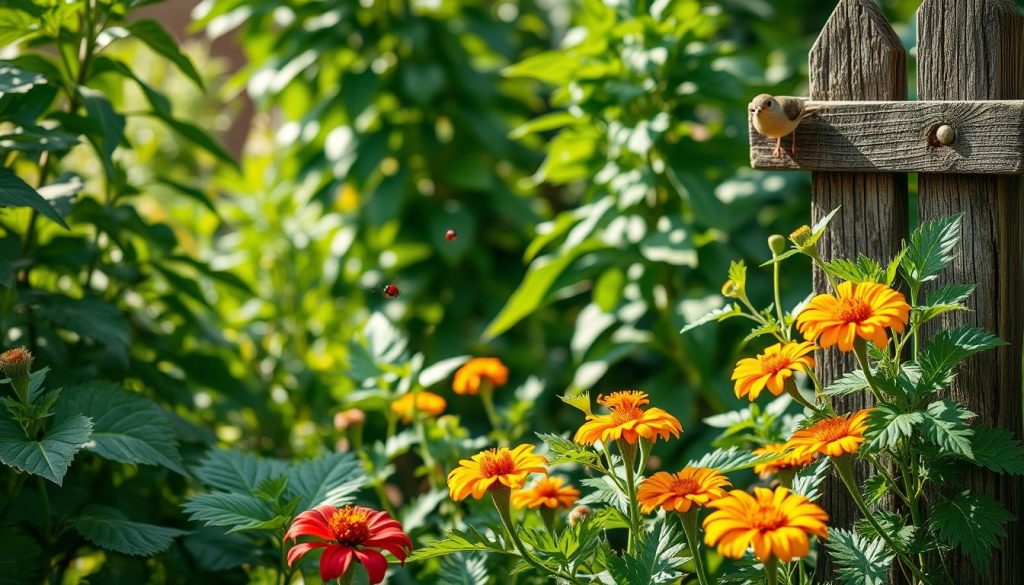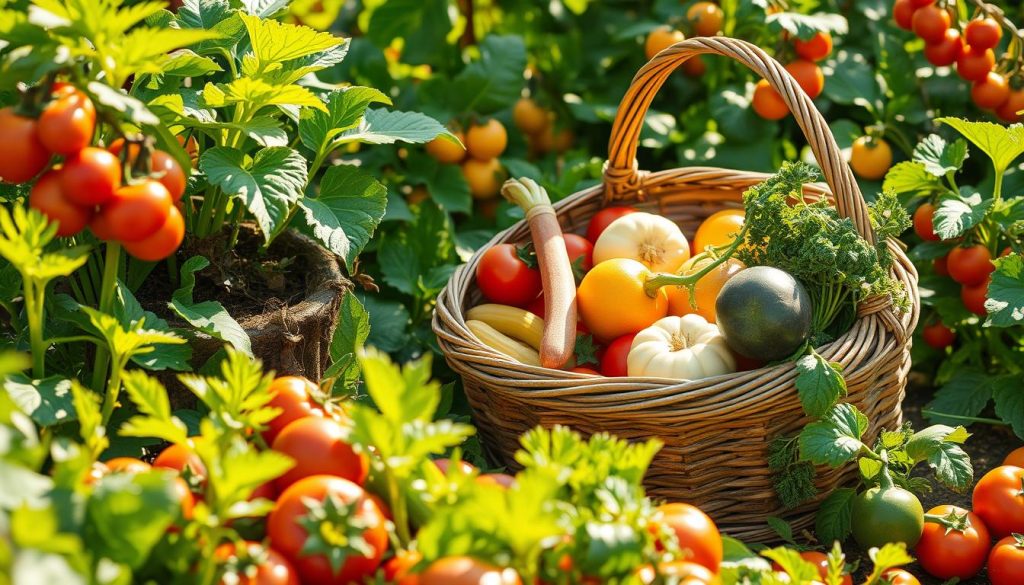I never thought my backyard could become an eco-friendly oasis. But when I discovered zero waste gardening, everything changed. This approach turned my outdoor space into a thriving, waste-free haven.
Zero waste gardening isn’t just about growing plants; it’s a mindset. It’s about working with nature, not against it. By embracing this method, I’ve cut down on waste, saved money, and created a beautiful, sustainable garden.
In my journey, I’ve learned that zero waste gardening is all about closing the loop. From composting kitchen scraps to saving seeds, every step aims to minimize waste and maximize resources. It’s a rewarding process that connects me to the earth in ways I never imagined.
Ready to dive into the world of zero waste gardening? Let’s explore how you can transform your garden into a sustainable paradise, one step at a time.
Understanding Zero Waste Gardening Principles
Zero waste gardening is a big change for sustainable gardening. It’s all about making a system where nothing is wasted. As a gardener, I’ve seen great results by following this approach.
The philosophy behind waste-free cultivation
Zero waste gardening is all about copying nature. In nature, everything is recycled. Leaves fall, break down, and feed the soil. This creates a perfect cycle.
By using these principles in our gardens, we make a mini-ecosystem. It’s self-sustaining and productive.
Environmental benefits of zero waste practices
Zero waste gardening is linked to organic gardening and permaculture. It reduces landfill waste and lowers our carbon footprint. Composting turns kitchen scraps into nutrient-rich soil.
Using rainwater harvesting saves water. These actions help fight climate change in our own backyards.
Economic advantages for home gardeners
Zero waste gardening can also save you money. I’ve cut my gardening costs a lot. Here’s how much you could save:
| Item | Traditional Cost | Zero Waste Cost | Annual Savings |
|---|---|---|---|
| Fertilizer | $50 | $0 (Compost) | $50 |
| Pest Control | $40 | $5 (DIY Solutions) | $35 |
| Seeds | $30 | $10 (Seed Saving) | $20 |
| Water Bill | $200 | $100 (Conservation) | $100 |
| Total Savings | $205 |
By adopting zero waste gardening, we make beautiful, productive gardens. We also help the planet and save money. It’s good for gardeners and the environment.
Setting Up Your Sustainable Garden Space
I’m excited to share my tips for creating a sustainable garden space. It’s perfect for urban gardening and eco-friendly practices. Whether you have a small balcony or a spacious backyard, you can design a thriving garden that follows permaculture principles.
Start by assessing your available space. Look for sunny spots that receive at least 6 hours of direct sunlight daily. If you’re working with limited room, consider vertical gardening options like wall-mounted planters or trellises.
Next, plan your garden layout. I recommend using raised beds or container gardens for better soil control and easier maintenance. Group plants with similar water and sunlight needs together to maximize efficiency.
Incorporate permaculture techniques by creating guilds – plant communities that support each other. For example, plant nitrogen-fixing beans near heavy feeders like tomatoes. This approach mimics natural ecosystems and reduces the need for external inputs.
| Garden Element | Eco-Friendly Option | Benefits |
|---|---|---|
| Pathways | Wood chips or gravel | Improves drainage, reduces mud |
| Borders | Reclaimed bricks or stones | Adds structure, reuses materials |
| Irrigation | Drip system or ollas | Conserves water, targets plant roots |
Remember to include a composting area in your garden design. This will help you recycle organic waste and create nutrient-rich soil for your plants. By following these guidelines, you’ll be well on your way to creating a sustainable, zero-waste garden space that thrives in harmony with nature.
Essential Tools for Zero Waste Gardening
Discovering the right tools has been key in my sustainable gardening journey. Let’s look at some eco-friendly gardening equipment. It will help you grow a healthy garden while cutting down on waste.
Reusable and Biodegradable Gardening Equipment
I choose tools that last, made from sustainable materials. Bamboo rakes, metal trowels, and wooden pruners are excellent. For planting, I use biodegradable pots from coconut coir or recycled paper. They dissolve in the soil, reducing plastic waste.
DIY Garden Tools from Recycled Materials
Being creative with recycled items is fun and sustainable. I’ve made plant markers from old wooden spoons and seed trays from egg cartons. Plastic milk jugs become watering cans, and tin cans are perfect for seedlings. These DIY projects save money and give new life to waste.
Maintaining and Repairing Garden Tools
To keep my tools in good shape, I clean them after each use and store them dry. I sharpen blades and oil wooden handles to prevent damage. When something breaks, I try to fix it instead of buying new. This way, I reduce waste and save money over time. Taking care of my tools means they’ll last for many seasons.
Soil Management: The Foundation of Zero Waste Gardening
Healthy soil is key to organic and sustainable gardening. In my zero waste garden, I work on making the soil fertile without using synthetic stuff. This method cuts down on waste and helps our garden ecosystem grow strong.
Cover cropping is a big part of my garden. I plant crops like clover or rye between seasons. They protect the soil and add organic matter when I mix them in. This is a big part of making the soil better and more diverse.
Mulching is also crucial in my garden. I use things like leaves, straw, or grass clippings to cover the soil. This keeps moisture in, stops weeds, and feeds the soil as it breaks down.
To make the soil even healthier, I do a few things:
- Crop rotation to keep nutrients in balance
- Minimal tilling to keep the soil structure intact
- Adding homemade compost to increase organic matter
- Using natural additives like bone meal or rock dust
By using these methods, my garden is not just productive. It also supports a lively soil ecosystem. This leads to healthier plants, more food, and a garden that shows what sustainable gardening is all about.
Composting: Turning Waste into Garden Gold
Composting is a key part of zero waste gardening. It’s a great way to cut down on food waste and make soil full of nutrients for your plants. Let’s look at how you can start composting and enjoy its benefits.
Types of Compost Systems
There’s a compost system for every garden size. In my small urban garden, I use a compact tumbler. For bigger yards, open bins are better. Here are some popular types:
- Tumblers: Easy to turn and rodent-proof
- Worm bins: Great for indoor composting
- Open piles: Simple and free, ideal for big spaces
- Enclosed bins: Tidy and efficient for medium-sized gardens
What to Compost
Composting helps reduce food waste. I add kitchen scraps, yard waste, and some paper products to my bin. Here’s a quick guide:
| Compostable | Avoid |
|---|---|
| Fruit and veggie scraps | Meat and dairy |
| Coffee grounds and filters | Oily foods |
| Eggshells | Diseased plants |
| Yard trimmings | Pet waste |
Troubleshooting Common Issues
Even experienced gardeners face composting problems. If your pile smells bad, it might be too wet or lack oxygen. Add dry materials and turn it more often. If it’s not breaking down, check the mix of green (nitrogen-rich) and brown (carbon-rich) materials. Aim for a 3:1 brown to green ratio.
Mastering composting is a big step towards zero waste gardening. It’s rewarding to see kitchen scraps turn into rich, fertile soil for your plants.
Water Conservation Techniques in the Garden

I’m passionate about eco-friendly gardening, and saving water is key. In my garden, I use many ways to save water and reduce waste. These methods help the planet and lower my water bills.
Rainwater harvesting is a big help. I collect rainwater in barrels to water my plants. It’s a free resource that’s perfect for gardening sustainably. Drip irrigation is also a favorite of mine. It waters plants right at the roots, cutting down on evaporation and runoff.
Mulching is simple but effective for saving water. I use organic mulch to keep moisture in and weeds out. This means I don’t have to water as often, and my garden stays tidy.
Choosing plants that don’t need much water is important. I’ve filled my garden with native plants that do well here without needing lots of water. These plants are not only pretty but also easy to care for.
| Water Conservation Technique | Benefits | Implementation Tips |
|---|---|---|
| Rainwater Harvesting | Free water source, reduces runoff | Install rain barrels, use gravity-fed systems |
| Drip Irrigation | Efficient water use, less evaporation | Install near plant roots, use timers |
| Mulching | Retains soil moisture, suppresses weeds | Apply 2-3 inches of organic mulch |
| Drought-Resistant Plants | Less water needed, low maintenance | Choose native species, group plants by water needs |
By using these water-saving methods, I’ve made a beautiful, eco-friendly garden. It’s amazing how small changes can make a big difference in water use and the environment.
Seed Saving and Propagation for Sustainability
In my journey through zero waste gardening, I’ve found that saving seeds and propagating plants are crucial. These practices not only cut down on waste but also keep your garden supplied with new plants.
Selecting Plants for Seed Saving
I pick plants for seed saving that are open-pollinated. These plants produce seeds that grow into the same type of plant. I look for healthy, strong plants with traits I want in my garden.
Proper Storage of Seeds
Keeping seeds in good condition is key. I store them in airtight containers in a cool, dark spot. For longer storage, I use silica gel to keep moisture away. Here’s a simple guide I follow:
| Seed Type | Storage Temperature | Expected Viability |
|---|---|---|
| Tomatoes | 50°F (10°C) | 4-10 years |
| Peppers | 50°F (10°C) | 2-5 years |
| Lettuce | 40°F (4°C) | 1-2 years |
Propagation Methods for Different Plants
Propagation is a great way to grow your garden without buying new plants. For herbs like basil and mint, I use stem cuttings. Perennials often get divided. Climbing plants do well with layering. These methods help my garden grow sustainably, reducing the need for store-bought seedlings.
Natural Pest Control Without Harmful Chemicals

In my organic gardening journey, I’ve learned that pest control doesn’t need harsh chemicals. Sustainable gardening offers natural ways to protect plants and the environment. By balancing your garden’s ecosystem, you can manage pests without synthetic pesticides.
Companion planting is a favorite eco-friendly technique of mine. Some plants naturally repel pests. For instance, marigolds near tomatoes keep aphids and nematodes away. Basil with peppers keeps flies and mosquitoes off.
Attracting beneficial insects is crucial for natural pest control. I plant flowers like daisies and yarrow to attract ladybugs, lacewings, and praying mantises. These bugs eat common garden pests, keeping things balanced.
When pests show up, I use homemade organic deterrents. A garlic, onion, and cayenne pepper spray keeps many insects away. For slugs and snails, I use crushed eggshells around plants. They won’t cross the barrier.
| Pest | Natural Control Method |
|---|---|
| Aphids | Ladybugs, neem oil spray |
| Caterpillars | Bt (Bacillus thuringiensis), hand-picking |
| Slugs | Eggshells, beer traps |
| Whiteflies | Yellow sticky traps, insecticidal soap |
Using these natural pest control methods, I’ve made a thriving, sustainable garden. It supports local ecosystems and gives me plenty of harvests. It’s great for gardeners and the environment!
Maximizing Space with Vertical and Container Gardening
Urban gardening can be tough, but we can make small spaces green and vibrant. I’ve found cool ways to use vertical and container gardening. These are great for those who love zero waste gardening.
Upcycled Container Ideas for Urban Gardens
I’ve turned old items into planters. Wooden crates are perfect for herbs, and boots are great for succulents. Even plastic milk jugs can hold small veggies with a few holes for drainage.
Building Vertical Garden Structures from Reclaimed Materials
Vertical gardening is key for small spaces. I’ve built walls with wooden pallets, full of greens and vines. Old gutters on fences are great for lettuce and strawberries.
Plant Selection for Space-Efficient Gardening
Picking the right plants is essential. I’ve found compact varieties that grow well in small areas. Here are my favorites:
| Plant Type | Recommended Variety | Container Size |
|---|---|---|
| Tomato | Tiny Tim | 5-gallon pot |
| Pepper | Patio Belle | 3-gallon pot |
| Cucumber | Spacemaster | 5-gallon pot |
| Lettuce | Little Gem | Window box |
| Herbs | Compact varieties | Small pots or hanging baskets |
These space-saving tips have turned my urban garden into a lush oasis. It shows that zero waste gardening is possible and brings nature right to my door.
Harvesting and Preserving Your Garden Bounty

In my zero waste gardening journey, I’ve learned that harvesting and preserving are key. By timing my harvests right, I maximize yields and keep my sustainable gardening practices on track.
I pick vegetables when they’re ripe but not overripe. This ensures peak flavor and nutrition. For leafy greens, I harvest outer leaves regularly, allowing inner leaves to keep growing. With herbs, I snip off stems just above leaf joints to encourage bushier growth.
Preserving excess produce is crucial in zero waste gardening. I use several methods:
- Canning: Great for tomatoes, pickles, and jams
- Freezing: Perfect for berries, peas, and corn
- Dehydrating: Ideal for herbs, fruits, and vegetables
To further reduce food waste, I practice root-to-stem cooking. Carrot tops make pesto, broccoli stems go into stir-fries, and beet greens are sautéed as a side dish. This approach aligns perfectly with sustainable gardening principles.
| Produce | Best Preservation Method | Shelf Life |
|---|---|---|
| Tomatoes | Canning | 12-18 months |
| Berries | Freezing | 6-8 months |
| Herbs | Dehydrating | 1-3 years |
By mastering these harvesting and preserving techniques, I’ve significantly cut down on food waste. I enjoy my garden’s bounty year-round. It’s a win-win for my kitchen and the environment!
Zero Waste Gardening in Different Climates
Zero waste gardening can thrive in any climate with a few tweaks. Let’s see how to make it work wherever you are.
Adapting zero waste techniques for arid regions
In dry areas, saving water is crucial. I use mulch to keep soil moist and collect rainwater when I can. Succulents and native plants are perfect for dry zones.
Wet climate challenges and solutions
In rainy areas, you need raised beds and good drainage. I choose water-loving plants and create rain gardens. Composting in wet climates requires extra care to avoid soggy piles.
Year-round zero waste gardening in temperate zones
Temperate climates offer the most flexibility. I use cold frames and greenhouses to grow all year. Crop rotation and companion planting help me use my space well in every season.

